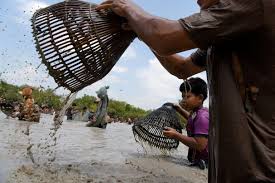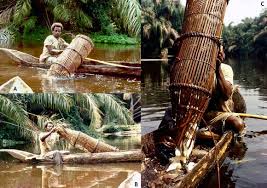Fisheries management systems in Nigeria involve both formal (government) and informal (traditional) institutions. Traditional management systems regulate fisheries activities and resources through traditional authorities or communities, which are united by common beliefs, norms, languages, and interests. In these systems, individuals do not have exclusive rights to resources and cannot dispose of or sell part or all of the system or resource being managed.
Traditional Fisheries Management Systems and Administration
Traditional fisheries management methods involve self-regulation by communities based on established practices aimed at controlling fishery exploitation. These management systems are administered by traditional authorities such as Bulamas, Sarkin Ruwas, or village heads, making them effective at the community level. According to Ita (1993), there are two types of fisheries management systems:
i. Inadvertent (unintentional), such as water tenure, ritual prohibitions, taboos, and magic.
ii. Intentional strategies, such as gear restrictions, closed seasons, and floodplain intensification.
Read Also: Bedbugs: Description, Damages Caused, Control and Preventive Measures
Community-Based Property Regimes in Traditional Fisheries

Traditional fisheries management methods are built on social agreements where individuals, groups, or communities have rights to resources. Property regimes determine stakeholders’ rights and responsibilities, providing incentives to preserve or invest in the resource.
These regimes, along with existing norms and values, form the framework for resource management. Fisheries are considered common property resources, where use rights are controlled by identifiable groups like local communities, who may exclude outsiders, with no direct government or state management.
Objectives of Traditional Fisheries Management in Nigeria
According to Neiland et al. (1997), traditional fisheries management in Nigeria aims to:
- Control fishing rights and reduce conflict.
- Generate food and income for the community.
- Conserve fish stocks.
The primary method of management is controlling access. Local leaders, traditional authorities, or the community set rules, and all users can have input into the process, creating a “bottom-up” approach under certain conditions.
Features and Objectives of Traditional Community-Based Fisheries Management Systems
Fisheries activities are regulated by traditional rules, beliefs, customs, and authorities based on indigenous knowledge. This approach is effective in areas where water boundaries are defined, such as lakes, floodplains, lagoons, and reservoirs.
Traditional rulers, religious leaders, shore masters, fish watchers, or chief fishermen are responsible for fisheries management, and the entire community enforces compliance with the rules. These rules are effective due to the legitimacy and acceptability of local authorities (Olomola, 1993). The main objective of fisheries management in this system is to protect the community’s interests.
Key aspects of this system include:
- Individuals within the community have access to the resource but cannot sell or dispose of fishing grounds, either temporarily or permanently.
- The village head and council of elders make decisions on behalf of the group, which are communicated to the community.
- This system is effective when population density is low and there is little internal or external pressure on the resource.
- Access to resources, harvesting, and consumption of fish are regulated socially and form part of resource management and allocation.
- Traditional authorities control access to fishing grounds, especially during fishing festivals. Seasonal closures, acceptable fishing gear, and other regulations are set by traditional authorities based on experience.
- There is no formal licensing system in place, but fisheries management regulations are rooted in the social concept of resource sharing, allowing all members to benefit from available resources.
- Sanctions may include fines, seizure of gear, and social penalties.
- Supernatural beings are often believed to set and enforce rules for resource use.
Management Measures in Traditional Fisheries Systems

Traditional fisheries systems use various management measures, including:
- Access control: Limiting the right of withdrawal to reduce fishing pressure. Access may also be granted as a territorial use right.
- Prohibition on capturing immature fish.
- Temporary or permanent restrictions on certain fishing gear, such as cast nets or pole and line.
- Prohibition of fishing in sacred waters and on certain festive days, which inadvertently protects fish stocks.
- Ban on the use of chemicals in fishing due to health concerns.
- Prohibition of the use of magical powers in fish harvesting.
- Emphasis on rituals for replenishing fish stocks, including sacrifices for rain, receding floods, and permission to fish.
- Avoiding consumption of certain fish species due to cultural taboos.
- Use of closed seasons to allow for fish reproduction, often coinciding with fishing festivals.
- Protection of sensitive areas, such as mangrove swamps or other nursery areas, during breeding seasons.
Factors Influencing the Acceptance of Traditional Fisheries Management
The acceptance of traditional knowledge in fisheries management is based on several factors, including:
- Alignment with traditional beliefs and customs.
- Rules that are consistent with well-established social systems, such as kinship and language.
- Easy detection of violations and prompt sanctions for offenders.
- Effective policing of communal territorial waters.
Limitations of Traditional Authority in Fisheries Management
Traditional fisheries management faces several limitations due to its reliance on traditional authority:
- Declining authority of traditional institutions, driven by modern societal changes, reduced adherence to traditional rules, urbanisation, and migration.
- Limited authority over resources, particularly when fishing grounds span multiple traditional territories. Proper management requires coordination between different authorities, often leading to conflicts.
- Overlapping and conflicting roles between traditional and modern institutions, which undermines the effectiveness of traditional systems.
- Taxation of fisheries by local or state governments, which may reduce offerings and weaken the authority of traditional leaders.
Read Also: 10 Medicinal Health Benefits Of Jakhya (Cleoma viscosa)
Challenges to Traditional Fisheries Management in Modern Society

Traditional fisheries management is an informal system where water bodies and their fisheries are controlled by traditional authorities or religious bodies.
Communities that operate within these systems share similarities in language, religious beliefs, traditional practices, or common interests. These communities respect the authority of their traditional leaders and follow the rules governing fisheries.
However, the rise of modern societies and the challenges they present are increasingly putting pressure on these traditional systems.
Do you have any questions, suggestions, or contributions? If so, please feel free to use the comment box below to share your thoughts. We also encourage you to kindly share this information with others who might benefit from it. Since we can’t reach everyone at once, we truly appreciate your help in spreading the word. Thank you so much for your support and for sharing!

